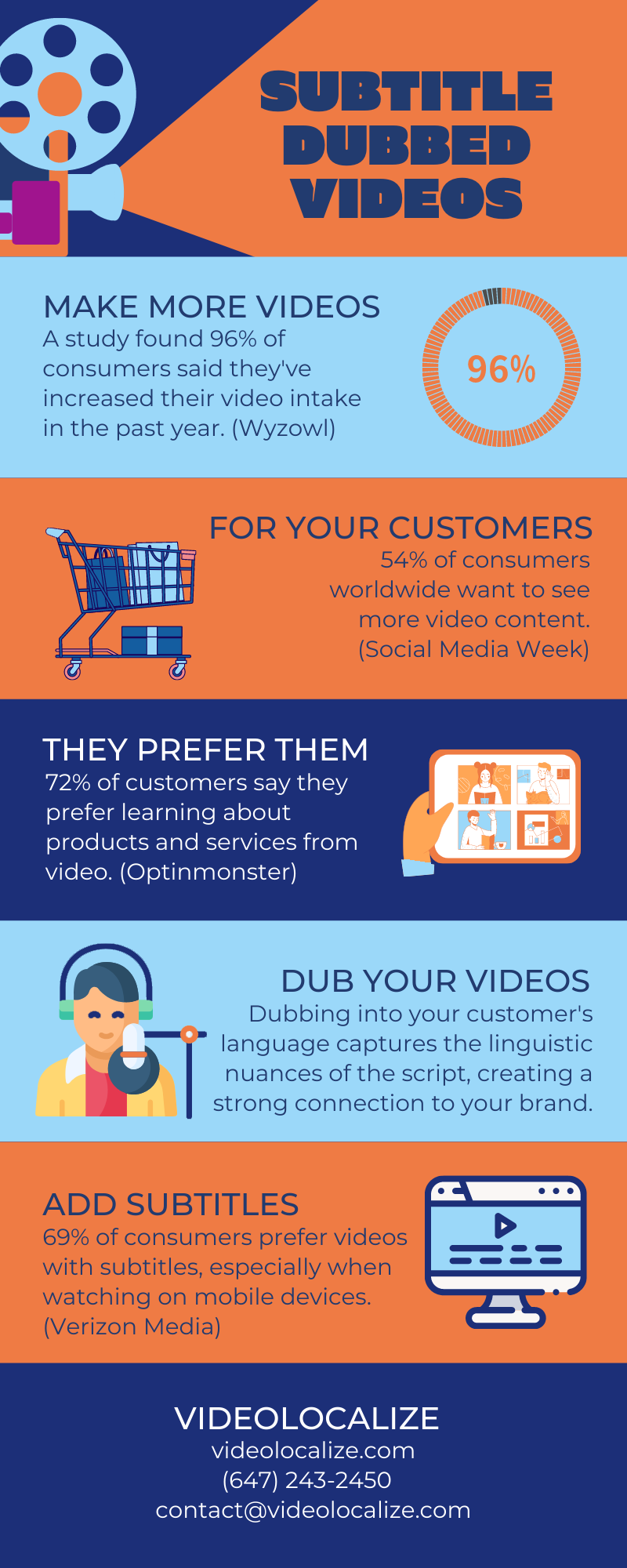
Why Subtitling Your Dubbed Videos Is a Good Idea
It’s no secret that video marketing works. Social Media Week reports 54% of consumers worldwide not only want to see more video content, but 72% say they prefer learning about products and services from video (Optinmonster). According to a study by Wyzowl, 96% of consumers are said to have increased their video intake in the past year.
This could be the reason why marketers who use video, grow revenue 49% faster than those who do not (Wordstream). Companies are also using video for internal communication. Video is proven to improve employee engagement, having a direct correlation to positive business outcomes (Forbes); this ranges from training guides to videos highlighting employees that go above and beyond.
But what happens after you’ve created a video for your customers or employees? If your company is global, you’ll want to first make sure it’s dubbed in the native language of your target audience. Even multilingual individuals tend to prefer listening to a video in their native language; the experience creates a strong emotional connection because a well-done voiceover can capture the linguistic nuances of the script. Dubbing also makes your video accessible to the visually impaired.
 Adding subtitles or captions after the video is dubbed is a good idea because it enriches the experience for many people. It also makes the video accessible to the hearing impaired. Subtitles and captions can be used in two different ways. Subtitles translate the spoken content of a video, whereas captions transcribe the spoken words and also inform the viewer about sounds or music on the video.
Adding subtitles or captions after the video is dubbed is a good idea because it enriches the experience for many people. It also makes the video accessible to the hearing impaired. Subtitles and captions can be used in two different ways. Subtitles translate the spoken content of a video, whereas captions transcribe the spoken words and also inform the viewer about sounds or music on the video.
When you add voiceover to a video in a foreign language to capture wider audiences, it’s highly recommended you also add subtitles in that foreign language.
Here’s why we recommend applying the two methods:
Subtitles and captions make your videos accessible to the hearing impaired who make up 5% of the world’s population, totaling 360 million. It’s not only considerate to make your content available to this portion of the population (in many countries, the financial and healthcare industry must provide video subtitles by law), but it’s also good business sense.
Besides making your videos accessible, it turns out 69% of consumers prefer videos with subtitles, according to Verizon Media. That number increases to 92% for people watching on mobile devices. That could be for a variety of reasons, but usually it’s because it’s not always convenient to have sound on. For example, a viewer might be waiting at their dentist’s office and not wish to be a nuisance to other patients. Or they may be in a noisy place where it’s difficult to hear the audio.
Even when people watch video with sound on, many find that captions or subtitles helps them better understand everything being said, thereby enriching the experience. People love content with visuals but they can get bored easily. Making sure the content you’re offering will benefit in some way should be supported with clear communication both with voiceover and subtitles to increase engagement.
Someone riding the Metro in Paris will find subtitles or captions on videos as convenient as someone waiting for their train in Brazil. Likewise, someone watching a video in French at home in Montreal, with sound on, will find the subtitles as helpful to capturing the message as someone watching the same video in English in New York.
With so many good reasons to subtitle your dubbed multilingual videos, Subtitle Burner from Video Localize is the ideal tool. It’s an easy-to-use online tool that can quickly burn subtitles in any language you want.
You can customize how your subtitles look on the screen, choose the size, color, and background of the text for crisp and clear captions that will delight any audience.
For questions about our video localization services and technologies, feel free to get in touch. Our team is ready to help make your project a success.
